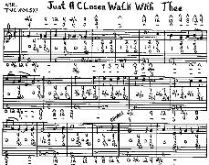
I missed most of the 1970s pop music scene, being completely immersed instead in Bix Beiderbick, Jelly Roll Morton, Cole Porter — and Beethoven, due to my then boyfriend now husband Steve a serious amateur trombone player and music fanatic. It was during that time that we discovered Bobby Short’s music when we heard it playing in a record store in Madison. It was love, total and complete which even resulted in a pilgrimage to the Cafe Carlyle when the price of the cover and two drink minimum wiped out our student savings but who cared we were experiencing the real amber glow of the guy singing our songs our way in his dream room in the dream city. (image is sheet music for “Just a Closer Walk with Thee,” here transcribed for concertina)
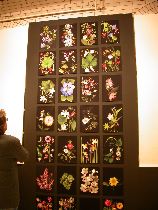
One of the songs I remember hearing repeatedly at Dixieland jazz fests is “A Closer Walk with Thee,” a traditional hymn that is a standard along with “Muskrat Ramble” and translates well from gospel to the jazz medium. And I bring it up here in this shaggy dog tale not only for the pun value but because I find that often when I respond to art I respond to it in a musical kind of way. So entwined are the music and art impulses in my brain, so deep and parallel are those neural shortcuts I’ve built up that they sometimes fire off interchangeably.(More on Dixieland music here.) (image is installation shot of Anne Skoogfors‘ “Botanica”)
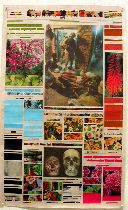
So when I saw the “Closer Look 6” exhibit at Arcadia University Art Gallery, the show of local artists who have previously been included in the college’s Works on Paper exhibit, I had the distinct audio-visual pleasure of hearing the work as well as seeing it. In other words, there’s music in this work — measured pace, repeat motifs and emotional underpinnings.
I’m going to let it go at that because I know that Libby’s working on something about the show and I’ll get to write more for the Weekly. Here are some musical accompaniments that I suggest. Or call up something else from your own personal jukebox of the mind.
M. Ho‘s fierce re-decorations of the news, “Nine untitled collages on newspaper (shown above is one of them)” — Janacek’s Fanfare from Sinfonietta (featuring a stately brass anthem that has tragedy, pomp and elegance. You can download a version here and if you’ve never heard it I highly recommend a listen.)
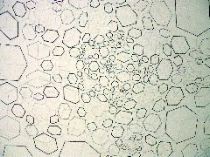
Bruce Pollock‘s first ever wall drawing, and it’s a beauty, “Every Infinite Place in Space ” — Handel’s Water Music and anything by Philip Glass. Both have cosmic nets of sound with star-like events.
(image is detail of Pollock‘s wall drawing)
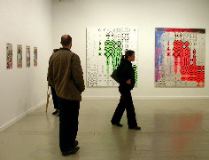
Carl Fudge‘s sexy sampling in “Overflow, Green and Orange” (installation shot) — Beck’s Odelay which samples and weaves together old and new and leaves a few rough edges.
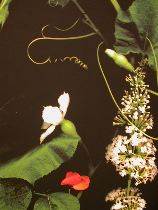
Anne Skoogfors‘s sad, beautiful “Botanica”
— Bobby Short’s rendition of “Autumn in New York” which rolls out like honey and is an elegy to beauty and love (image is detail of one of Skoogfors‘ “Botanicals”)









